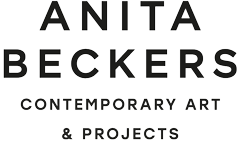with works by Christiane Feser, Sebastian Kuhn, Annegret Soltau and Peter Weibel.
Press release on February 18th, 2020
ARCOmadrid 2020:
Fair dates:
February 26th – March 1st, 2020
At ARCOmadrid 2020 Galerie Anita Beckers presents major works by Annegret Soltau (*1946 Lüneburg) and Peter Weibel (*1944, Odessa / UA) from the 1960s and 1970s, including photography, video and installations, some of which have never been presented before.
The aim is to create a dialogue between the works of these exceptional artists, based on their artistic avant-garde approach during those times and their controversial political respectively feminist themes.
Annegret Soltau’s search and questioning of her own female identity coincided with Peter Weibel’s political actions and performances concerning the identity of individuals and society.
With selected examples of both positions from the 60s and 70s, we open a window into their extensive work.
Annegret Soltau is a pioneer in the field of feminist art and Body Art, however, her works still generate controversy today. Again and again her artworks are considered offensive, are censored or pulled from exhibitions. In the digital age where the internet offers an anyonymous platform to users, such concrete and physical images seem disconcerting. Today, her work boasts an unbroken authenticity.
For over 50 years, the artist has occupied herself with her physical and mental identity. In doing so, she utilizes her environment, her family and children over and over in her work. Her creative work has been a journey into her own soul, thereby searching for ways to understand her own psyche.
Soltau recorded her personal fears and doubts via texts and diagrams before and during her pregnancies. This resulted in photographic and video works. The artist previously mostly neglected these artistic “documentaries”and never exhibited them. However, these works are essential to her oeuvre, because her entire work builds on them.
Soltau’s threads are utilized in various ways. In the article Annegret Soltau. Spinnen, Umgarnen, Nähen – emanzipatorische Fadenspiele (2015), Leena Crasemann wrote “Through the spider and later mainly through sewing, Soltau uses cultural techniques that are hundreds of years old and connects them to photography. In this way she deconstructs the femininely coded techniques of handiwork and, through her approach, creates a critical, constructive new occupation of the dichotomies of handiwork versus art, masculine versus feminine, photographic image versus installative object – and this is where the avant garde, emancipatory potential of her own artistic language was founded”.
The majority of the works that we show at ARCO are vintage photographs from the 1970s that have not been exhibited so far.
Though mainly recognized as an art theorist and museum director of the ZKM | Center for Art and Media in Karlsruhe, Peter Weibel has been creating an extensive body of art since 1964. His work looks into several themes, such as the mechanisms of perception and thought, the properties of the apparatus, the crisis of representation, of the image and the museum, the relationship between art, politics and economics and the conditions under which art operates.
Specifically, one of Weibel’s most distinctive contributions was to transform language and media into fields of action, and to emphasize audience participation from an early age. This not only anticipated but also had a deep impact on media art being done by subsequential generations.
Between 1965 and 1978, in the form of performances, happenings and actions, Weibel pursued a thorough investigation on identity and the effects of art.
Deeply connected to the traditions of the avant-garde, for him the process always remained more important than the documentation artifacts resulting from it. He coined the term of the “Viennese Actionism” at that time, as one of their main protagonists. Iconic of this period are also street pieces such as ‘Tap and Touch Cinema‘ (1968) and ‘From the Portfolio of Doggedness’ (1968), created in collaboration with Valie Export.
Fascinated with scientific research and technological progress from an early stage, Weibel’s purpose was always to draw out our affective responses. ‘Raum der Sprache’ (1973) humorously deals with that.
This was followed by an intense research on the relationship between subject and system, individual versus institution, making a case for individuality as a construct, of which the 1968 three-channel projection ‘Fingerprint’ (1968) is a great example. Unlike other artists whose performance work derived from painting-related issues, Weibel primarily dealt with media and technology.
Peter Weibel’s work appropriates the technical means and processes ordinarily used in the production of mass media images, to present them under a completely different light. His work addresses the limits and paradoxes of the technological progress, the absurdities and inconsistencies that lay already within them. With humour, again and again, this analytical dimension draws attention not only to the opportunities but also to the shortcomings and inconsistencies of today’s media system.
At ARCO we create a selective dialogue between the early works of Peter Weibel and Annegret Soltau, which opens a window into each artist’s extensive oeuvre from the 1960s and 1970s using photography and video.
Please contact the gallery for more information.

